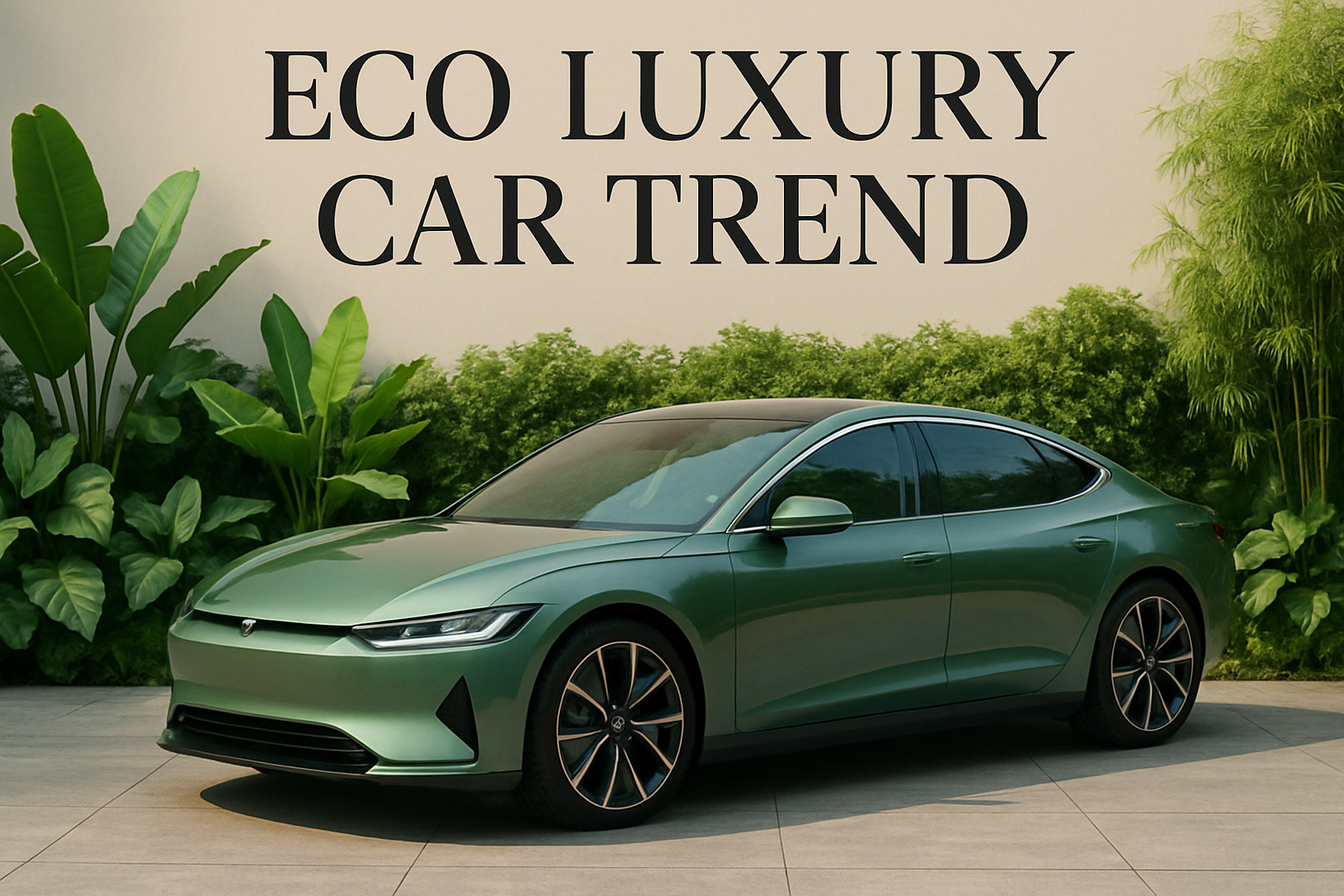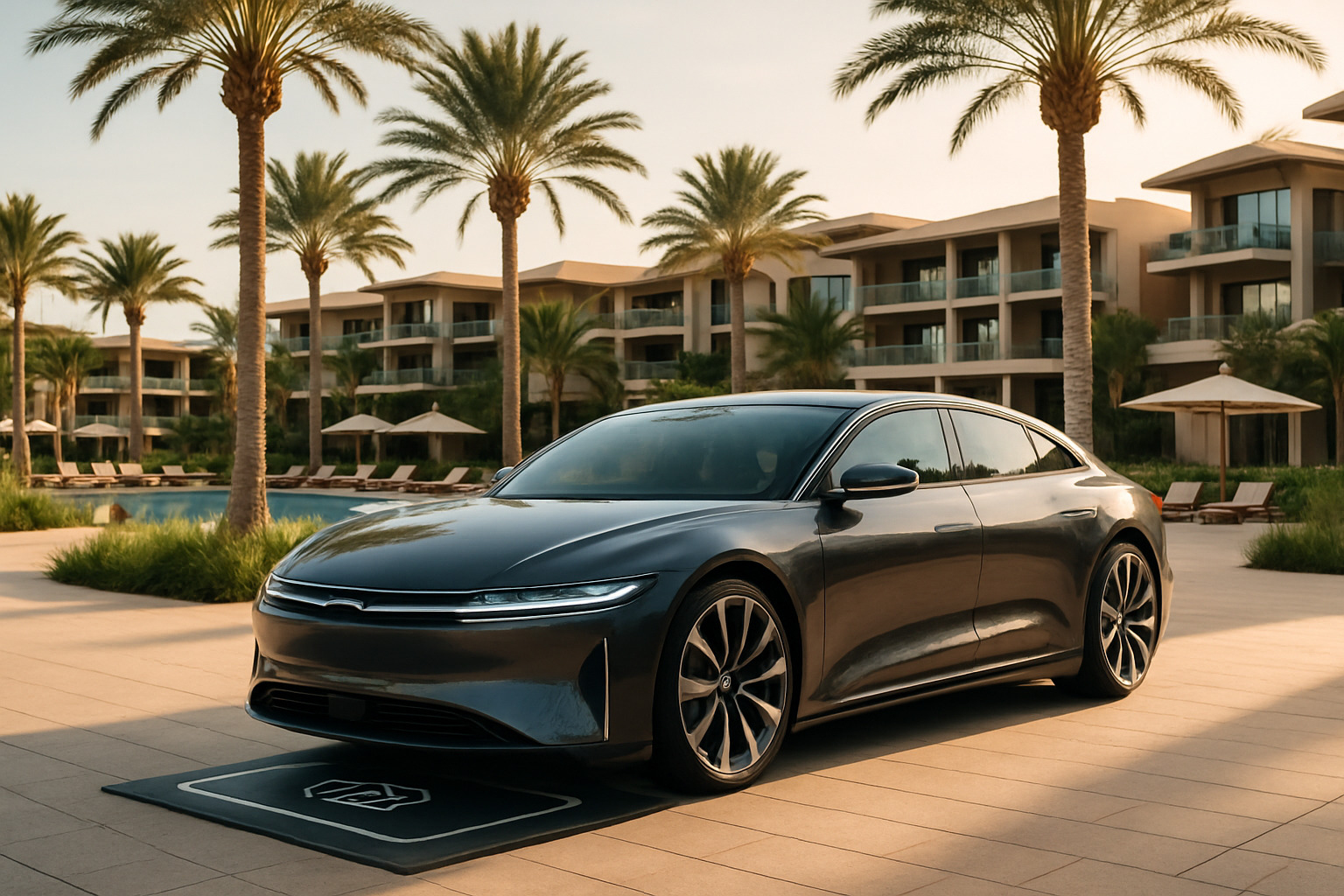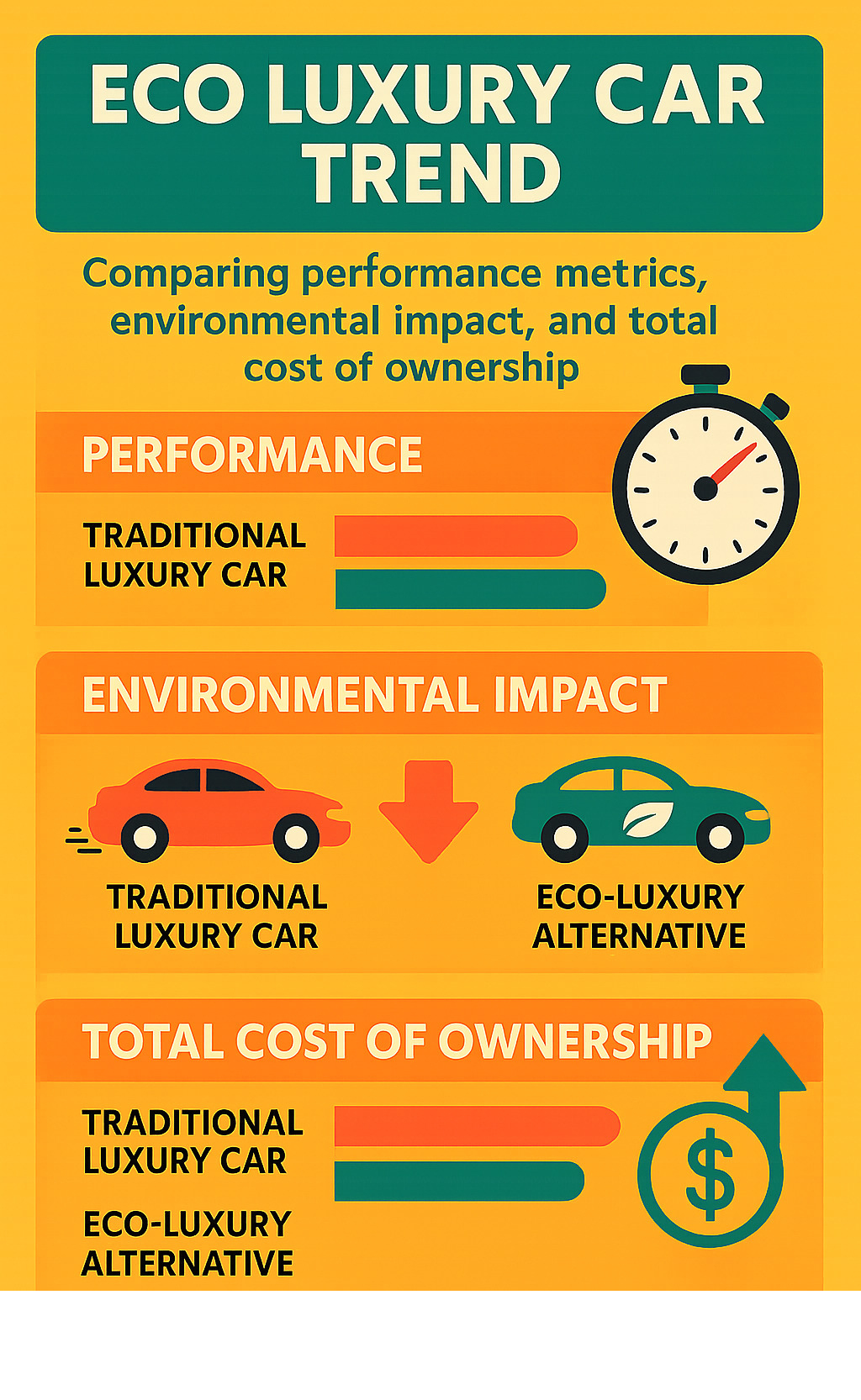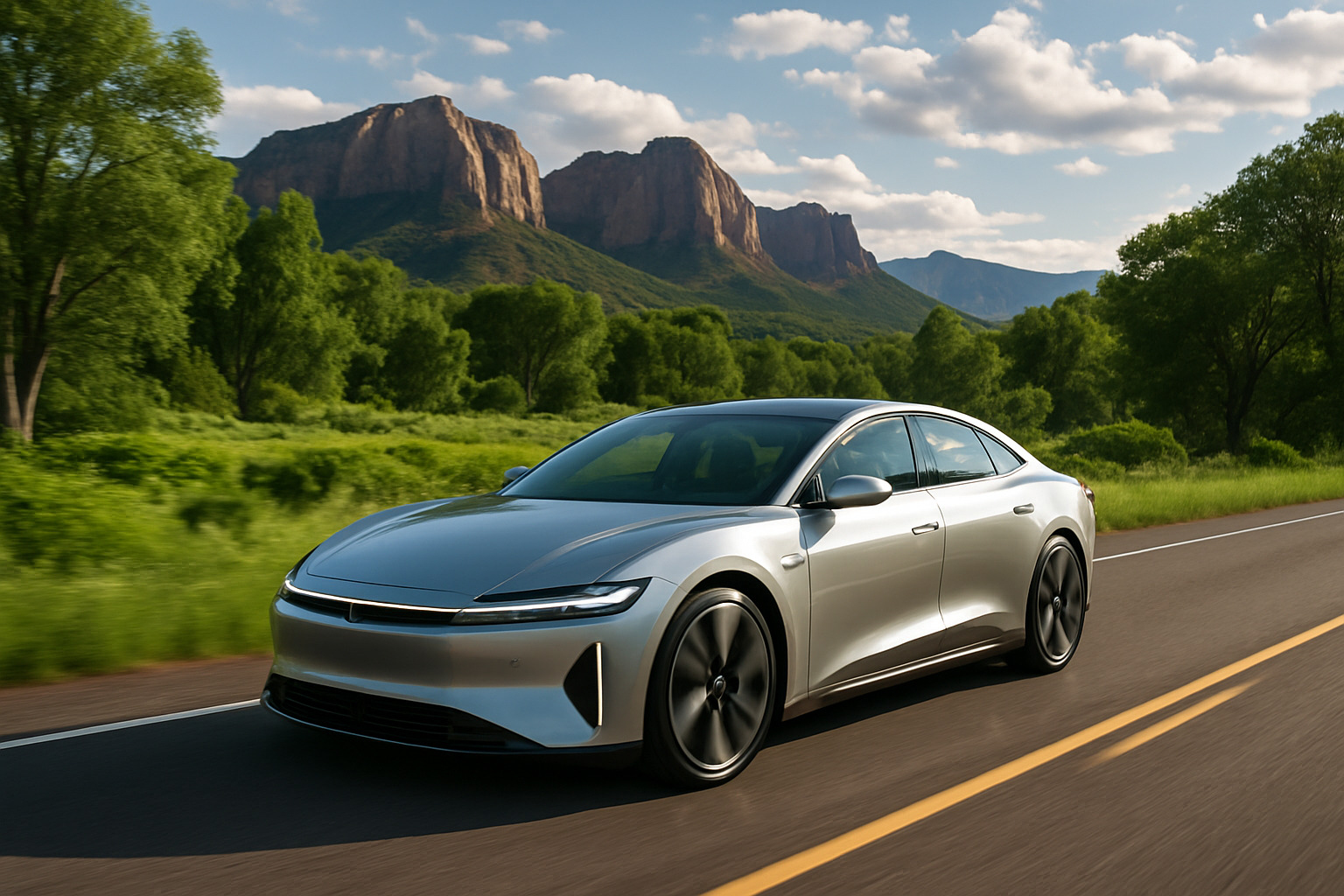Eco Luxury Car Trend: 8 Powerful Shifts Redefining 2025
Why the Eco Luxury Car Trend is Reshaping the Automotive Industry
The eco luxury car trend is changing how we think about premium vehicles. Here’s what’s driving this massive shift:
Key Trends Driving Eco Luxury Cars:
– Market Growth: Luxury car market projected to reach $920.17 billion by 2029 at 8.2% CAGR
– Consumer Demand: 73% of Millennials willing to spend more on sustainable products
– Electric Dominance: Tesla luxury EV deliveries increased 40% yearly to 1.31 million in 2022
– Regional Expansion: Asia-Pacific leads luxury car adoption with 14% annual growth
– Technology Integration: 800V fast-charging, vegan interiors, and AI personalization
The automotive world is experiencing what one industry expert calls a “seismic shift” as affluent customers demand eco-friendly alternatives without compromising style or performance. Traditional luxury – once defined by roaring V12 engines and hand-stitched leather – is being redefined by sustainability.
This isn’t just about swapping gas for batteries. Modern eco luxury cars combine instant torque that outperforms traditional supercars, zero-emission powertrains, and interiors crafted from innovative materials like cactus leather and recycled ocean plastics.
The numbers tell the story clearly: luxury brands are racing to electrify their entire lineups, with companies like Rolls-Royce committing to all-electric vehicles by 2030. Meanwhile, younger consumers – especially Gen Z digital natives – view environmental responsibility as the new status symbol.
What makes this trend particularly compelling is how it’s expanding rather than limiting luxury experiences. Electric powertrains free up interior space for wellness features, while connected technologies enable personalized, over-the-air updates that continuously improve the driving experience.

Eco luxury car trend definitions:
– luxury car customization options
– luxury car interior design trends
– luxury car trends
The Global Shift Fueling the Eco Luxury Car Trend
Something remarkable is happening in the luxury car world right now. We’re witnessing what industry experts call a “perfect storm” – where government pressure, changing values, and incredible economic opportunity are all pushing the eco luxury car trend forward at breakneck speed.
Just five years ago, most luxury buyers wouldn’t consider an electric vehicle. Today, they’re lining up for them. The global luxury car market is experiencing “electrification and sustainable luxury” as the dominant theme.
The Asia-Pacific region has emerged as the largest luxury car market in 2024, with China’s above-$80k luxury segment growing at an impressive 14% annually. This explosive growth is being fueled by an expanding population of ultra-high-net-worth individuals, projected to reach over 700,000 globally by 2026.
Scientific research on conscious consumers confirms that 73% of Millennials are willing to spend more on products from sustainable brands. For these buyers, sustainability has become a core luxury attribute rather than a compromise.
Government Policies and Incentives Accelerating Adoption
Governments are creating comprehensive policy frameworks using both carrots and sticks to accelerate the eco luxury car trend.
Zero-emission zones in cities like London, Paris, and Beijing are creating immediate market demand for electric luxury vehicles. These policies make traditional luxury cars impractical for urban use, forcing a rapid transition that many buyers are embracing enthusiastically.
Tax incentives are making eco luxury cars financially attractive. Many countries offer substantial rebates for electric vehicle purchases, with some luxury EV buyers receiving credits worth thousands of dollars. These incentives often extend to charging infrastructure installation.
The most ambitious policies focus on carbon-neutral mandates pushing luxury brands to reimagine their operations. Companies are responding with impressive commitments – like carbon neutrality goals by 2039 and the development of the UK’s first carbon-neutral luxury automotive plants through solar installations and renewable energy adoption.
Economic Drivers and Market Forecasts
The economic fundamentals supporting the eco luxury car trend show incredible growth and opportunity. Industry analysts project the luxury car market will grow from $623.9 billion in 2024 to $920.17 billion by 2029 – that’s a compound annual growth rate of 8.2%.
Rising disposable incomes in emerging markets are creating entirely new pools of luxury car buyers. Research indicates that emerging economies like China and India will see an 85% surge in millionaires by 2033, dramatically expanding the potential customer base for eco luxury vehicles.
SUVs are expected to capture an increasing share of the luxury market, rising from under 25% in the $80k-$149k segment in 2021 to 40% by 2031. This trend favors electric powertrains, which are particularly well-suited to luxury SUV packaging requirements.
Research shows that more than 70% of current premium gas car owners are willing to switch to EVs at their next purchase. This represents a massive potential market waiting for the right vehicles to become available.
Technologies Powering Green Luxury

The heart of the eco luxury car trend beats with technology that’s completely reshaping what we expect from premium vehicles. It’s not just about swapping out engines – we’re witnessing a complete change of how cars are built, powered, and experienced.
Battery Electric Vehicles (BEVs) are leading this revolution with impressive capabilities that would have seemed impossible just a few years ago. Modern luxury EVs routinely deliver over 400 miles of range while providing instant torque that makes traditional supercars feel sluggish. The instant power delivery creates a driving experience that’s both thrilling and whisper-quiet – a combination that’s redefining performance luxury.
Plug-in Hybrid Electric Vehicles (PHEVs) serve as the perfect stepping stone for luxury buyers who want the best of both worlds. These sophisticated systems combine electric motors with traditional engines, offering the flexibility of long-distance travel while providing pure electric driving for daily commutes. It’s like having two cars in one – practical for road trips, yet environmentally conscious for city driving.
Perhaps the most exciting breakthrough is 800V fast-charging technology. The latest luxury EVs can charge from 10% to 80% in under 20 minutes, making charging stops shorter than a coffee break. This addresses the biggest concern luxury buyers have about electric vehicles – the fear of being stuck waiting for hours at charging stations.
Hydrogen fuel cell technology is emerging as an intriguing alternative, offering the promise of five-minute refueling with zero emissions. While still developing, hydrogen presents a compelling option for luxury buyers who prioritize convenience and range.
Solid-state batteries represent the next frontier, promising even faster charging, longer range, and improved safety. These advanced batteries could deliver 1,000-mile ranges and charge in minutes rather than hours.
| Technology | Range | Charging Time | Emissions |
|---|---|---|---|
| Battery Electric (BEV) | 300-400+ miles | 20-45 minutes (fast charging) | Zero local emissions |
| Plug-in Hybrid (PHEV) | 300-500+ miles total | 2-4 hours (plug-in) + gas | Reduced emissions |
| Hydrogen Fuel Cell | 300-400 miles | 3-5 minutes | Zero emissions (water vapor) |
Sustainable Materials & Circular Manufacturing
The eco luxury car trend is revolutionizing what luxury looks and feels like inside the cabin. Gone are the days when sustainability meant compromise – today’s eco-friendly materials often exceed traditional materials in both performance and aesthetic appeal.
Cactus leather is making waves as a premium alternative to traditional cowhide. This innovative material requires no chemical tanning, produces zero wastewater, and avoids the environmental impact of cattle farming entirely. The texture and durability rival traditional leather while offering a unique story that resonates with environmentally conscious buyers.
Econyl nylon represents circular economy principles at their finest. This remarkable material is created from discarded fishing nets and plastic waste pulled from our oceans. What was once pollution becomes premium carpeting and upholstery that’s infinitely recyclable. It’s luxury with a purpose that you can literally feel good about.
Vegea grape leather takes sustainability to delicious new heights. Made from grape skins left over from wine production, this material transforms agricultural waste into supple, attractive interior surfaces. It’s a perfect example of how creativity and environmental responsibility can create something truly special.
Bamboo fiber composites are replacing traditional plastics in dashboards and trim pieces. Bamboo grows incredibly fast, requires no pesticides, and creates materials that are both lighter and stronger than conventional alternatives. The weight savings directly translate to improved range and performance in electric vehicles.
Manufacturing itself is becoming more sustainable through net-zero production facilities. Luxury brands are investing heavily in renewable energy, waste reduction, and supply chain transparency. Some facilities now recycle over 60% of their waste while running entirely on solar and wind power.
More info about Automotive Sustainability Initiatives
The beauty of these innovations is that they don’t require buyers to sacrifice anything. These sustainable materials often feel more luxurious than traditional options while telling a compelling story about environmental stewardship.
Digital Luxury and Over-the-Air Experiences
The eco luxury car trend is being liftd by digital technologies that make every drive feel personalized and constantly improving. The modern luxury car is essentially a smartphone on wheels – but with much better seats and climate control.
Connected cockpits have transformed the interior experience with multiple high-resolution displays that respond intuitively to touch, voice, and gesture commands. These systems integrate seamlessly with your digital life, making the transition from home to car feel effortless.
Over-the-air updates represent perhaps the most exciting shift in luxury car ownership. Instead of your car slowly becoming outdated, it actually gets better over time. New features, performance improvements, and interface improvements arrive automatically while you sleep. It’s like having a car that evolves and improves throughout your ownership experience.
AI personalization is taking customization to incredible new levels. Future systems learn your preferences and automatically adjust everything from seat position and climate settings to route planning and entertainment choices. Imagine a car that knows you prefer jazz on Monday mornings but needs energizing music for Friday evening drives.
Subscription features allow owners to try new capabilities without committing to permanent purchases. Want to test advanced driver assistance for a month? Curious about premium audio systems? Digital luxury lets you sample features before deciding what’s worth keeping long-term.
Data services are creating entirely new ways to improve the ownership experience. Carbon tracking apps help you understand and minimize your environmental impact, while predictive maintenance systems can schedule service appointments before problems develop. It’s luxury that’s both intelligent and proactive.
This digital change means luxury cars are becoming more like premium technology products – constantly improving, deeply personalized, and surprisingly delightful in unexpected ways.
Consumers Redefining Prestige in the Eco Luxury Car Trend

The automotive world is experiencing a fundamental shift as affluent customers demand eco-friendly alternatives. The traditional symbols of prestige – roaring engines and exotic leather – are being replaced by environmental responsibility as the new status symbol.
This shift in the eco luxury car trend represents a fundamental change in values. Gen Z and younger Millennials grew up during climate change discussions and social media activism. For them, driving a gas-guzzling supercar doesn’t scream success – it whispers guilt.
These digital natives expect their luxury cars to work like their smartphones. They want seamless experiences that flow between online research, virtual showrooms, and real-world test drives. The idea of spending hours at a traditional dealership feels outdated.
Modern luxury buyers are more interested in time and experiences than just expensive materials. They want cars that provide peaceful moments away from digital chaos while still offering cutting-edge connectivity when needed.
Scientific research on Gen Z mobility reveals that younger consumers often prioritize access over ownership, sustainability over status, and experiences over possessions.
Key Features Modern Buyers Expect in the Eco Luxury Car Trend
Modern buyers want instant torque as the new horsepower bragging right. Electric motors deliver their full power immediately, creating an acceleration experience that makes traditional engines feel sluggish.
The cabin has transformed into a wellness sanctuary. Buyers expect air purification systems, circadian rhythm lighting that adjusts throughout the day, and ergonomically designed seats. Some luxury EVs now offer meditation modes that optimize everything from lighting to audio for relaxation.
Vegan interiors have moved from niche request to mainstream expectation. Modern luxury buyers want beautiful materials that don’t compromise their values – premium textiles, open-pore wood, and innovative touch-responsive surfaces that feel as luxurious as traditional leather.
Level 3 autonomous driving features are considered baseline equipment. Adaptive cruise control, lane-keeping assistance, and automated parking are expected standard features that improve over time through software updates.
The infotainment system needs to be as smart as a personal assistant. Modern buyers want their cars to sync with their calendars, know their preferences, and provide personalized recommendations. The car should feel like an extension of their digital life.
Ownership Models for a New Era
The traditional “buy it and keep it for years” approach is giving way to more flexible options. Subscription services are gaining serious traction, with over 40% of high-end buyers expressing interest in subscription models over traditional ownership or leasing.
Direct-to-consumer sales are disrupting the dealership experience. Luxury brands are opening boutique-style showrooms that feel more like premium fashion stores than traditional car lots, focusing on education and experience rather than inventory pressure.
Online checkout capabilities have become essential. Research shows that over 40% of high-end buyers now prefer completing their purchases online, expecting the same seamless experience they get from other luxury brands.
Carbon tracking apps are turning sustainability into an engaging, measurable experience. These applications provide detailed information about environmental impact, renewable energy usage, and carbon offset opportunities.
More info about Luxury Electric Vehicle Market
The eco luxury car trend is fundamentally changing how we think about prestige, ownership, and the relationship between luxury and responsibility.
Balancing Performance, Exclusivity, and Sustainability

The eco luxury car trend faces the complex challenge of maintaining traditional luxury attributes while embracing sustainability. Performance has actually improved with electrification – many luxury EVs now achieve 0-60 mph times that surpass traditional supercars while delivering whisper-quiet operation.
Range anxiety is becoming less of an issue as battery technology advances. The Tesla Model S offers over 400 miles of range, while the Mercedes-Benz EQC provides 259 miles with 80% charging in just 40 minutes. Fast-charging infrastructure is expanding rapidly, with luxury brands partnering to create premium charging experiences.
However, raw material sourcing presents ongoing challenges. Battery production requires lithium, cobalt, and rare earth elements that raise environmental and ethical concerns. Luxury brands are investing in responsible sourcing programs and battery recycling initiatives to address these issues.
Grid capacity and renewable energy integration are critical for realizing the full environmental benefits of luxury EVs. Brands are partnering with renewable energy providers and installing solar charging stations to ensure their vehicles are powered by clean energy.

Opportunities for Automakers and Investors
The eco luxury car trend creates significant opportunities for forward-thinking automakers and investors. Carbon-neutral branding is becoming a powerful differentiator, with companies like Bentley achieving carbon neutrality at their Crewe facility and using this as a marketing advantage.
Circular revenue streams are emerging through battery-as-a-service models, subscription features, and material recycling programs. These create ongoing revenue opportunities beyond the initial vehicle sale.
Experiential luxury is expanding beyond the vehicle itself. Luxury brands are creating comprehensive mobility ecosystems that include charging networks, concierge services, and exclusive experiences for owners.
Data monetization presents significant opportunities while enhancing customer experience. Luxury brands can provide personalized services, predictive maintenance, and performance optimization while generating additional revenue streams.
Ongoing Challenges
Despite the momentum behind the eco luxury car trend, several challenges remain. Cost parity with traditional luxury vehicles is still an issue, though this gap is narrowing rapidly as battery costs decline and production scales increase.
Raw material scarcity could become a limiting factor as demand for luxury EVs grows. The industry needs to develop more efficient recycling processes and alternative battery chemistries to ensure sustainable growth.
Charging infrastructure gaps, particularly in rural and remote areas, continue to limit adoption among some luxury buyers. While urban charging networks are expanding rapidly, “charging deserts” remain a concern for buyers who frequently travel to remote locations.
Durability concerns about new sustainable materials need to be addressed through extensive testing and real-world validation. Luxury buyers expect materials to maintain their appearance and functionality over many years of use.
Greenwashing risks are significant as more brands claim sustainability credentials. Consumers are becoming more sophisticated about evaluating genuine sustainability efforts versus marketing claims.
Frequently Asked Questions about the Eco Luxury Car Trend
How fast can luxury EVs recharge today?
The charging speeds we’re seeing in today’s luxury EVs would have seemed impossible just a few years ago. The Lotus Emeya has set a new benchmark with its incredible 350kW charging capability, taking you from 10% to 80% charge in just 18 minutes. That’s barely enough time to grab a coffee and check your messages.
Other luxury models are impressive too. The Audi e-tron reaches 80% charge in 30 minutes, while the Mercedes-Benz EQC gets there in 40 minutes. These speeds are achieved using high-powered DC fast chargers, which are popping up everywhere from luxury shopping centers to premium hotels.
What makes this even better is how luxury brands are treating the charging experience itself. Many are partnering with charging networks to create premium charging experiences complete with lounges, concierge services, and amenities that make charging time feel less like waiting and more like a brief luxury break.
Do sustainable interiors compromise durability or feel?
Here’s where the eco luxury car trend really shines – sustainable materials actually improve the luxury experience rather than compromise it. Cactus leather, marketed as Deserttex, provides that premium texture you expect without any of the environmental guilt that comes with traditional leather.
Econyl recycled nylon is another game-changer. Made from discarded fishing nets and plastic waste, it offers the same durability as virgin materials while literally cleaning up our oceans. BMW’s extensive testing shows that sustainable materials like Mirum and Dinamica maintain their appearance and functionality just as well as traditional options.
The Land Rover Evoque proves this point perfectly – its 32 kg of natural and recycled materials have proven just as durable as conventional materials while significantly reducing environmental impact. Many luxury buyers tell us these sustainable interiors actually feel more premium because they align with their values.
There’s something deeply satisfying about knowing your vehicle’s interior is crafted from recycled ocean plastic or innovative plant-based materials. It adds an emotional dimension to luxury that traditional materials simply can’t match.
What incentives exist for purchasing an eco-luxury vehicle?
The financial incentives for eco-luxury vehicles can be surprisingly generous, though they vary quite a bit depending on where you live. In the United States, federal tax credits up to $7,500 are available for eligible electric vehicles, and many states stack additional rebates on top of that.
European countries often go even further with their incentives. Norway has created an incredibly attractive package with exemptions from purchase taxes and tolls, while Germany provides substantial purchase rebates. The UK offers grants specifically for home charging station installation, making the transition even smoother.
China’s New Energy Vehicle policies include purchase subsidies and preferential licensing for electric vehicles in major cities – a huge advantage given how competitive license plates can be in places like Shanghai and Beijing.
What many luxury buyers find is that the combination of purchase incentives, lower operating costs, and tax advantages makes eco-luxury vehicles surprisingly competitive financially compared to traditional alternatives. When you factor in the lower maintenance costs and the satisfaction of driving something that aligns with your values, the eco luxury car trend becomes not just environmentally responsible but financially smart too.
Conclusion
The eco luxury car trend represents something far more profound than swapping gas engines for electric motors. We’re watching luxury itself get completely redefined for a new generation of buyers who see sustainability as the ultimate status symbol.
What’s happening right now feels like a turning point. The luxury car market is racing toward $920.17 billion by 2029, and electric vehicles are leading that charge across every price tier. But the real story isn’t just about numbers – it’s about how time itself is becoming the new luxury.
Think about it: instead of spending time at gas stations, luxury EV owners are charging at home while they sleep. Instead of dealing with engine noise and vibration, they’re enjoying whisper-quiet cabins designed for wellness and relaxation. Instead of worrying about emissions, they’re tracking their positive environmental impact through sleek mobile apps.
The eco luxury car trend is actually expanding what luxury can be rather than limiting it. We’re seeing performance that traditional supercars can’t match, thanks to instant electric torque. Interiors crafted from innovative materials like cactus leather and recycled ocean plastic that feel more premium than traditional options. Connected experiences that continuously improve through over-the-air updates.
What excites us most is how this shift is creating entirely new categories of luxury experiences. Holistic mobility that seamlessly blends sustainable transportation with personalized digital services, wellness-focused cabin environments, and carbon-neutral ownership experiences that align with buyers’ values.
The brands that truly understand this change – and the consumers driving it – are the ones shaping the future of automotive luxury. They’re not just building cars; they’re creating sustainable lifestyle ecosystems that make ownership feel effortless and responsible.
For those of us passionate about where car culture is heading, this feels like the most exciting chapter yet. The eco luxury car trend isn’t just changing how we drive – it’s redefining what it means to experience automotive excellence in the 21st century.







